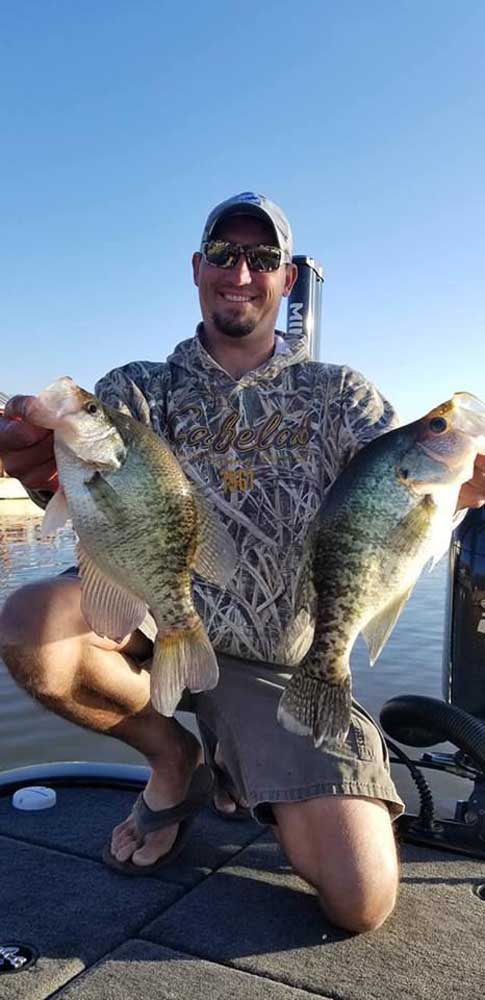Winter can be a good time for crappie fishing
Published 11:12 pm Friday, December 21, 2018

- William Oliver took advantage of a mild December day to catch crappie on Lake Palestine. When the water turns cold, the fish move deep and can be caught consistently. (Tommy Ezell/Courtesy)
I have to admit my first and only foray into winter crappie fishing was not a good time. Maybe it was the 6 inches of snow on the ground. It could have been the single-digit temperature. I think it was because I could not find a match to catch the boat on fire so I’d warm up.
Apparently not everyone else has the same experience because to crappie fishermen the winter season is an important time. In fact, for those who can withstand the conditions or find a mild day, it might be the best time of year to catch the fish.
“Crappie fishing in the winter is as good or better than the springtime pattern to many people on East Texas lakes,” explained guide William Oliver.
Fish are a cold-blooded species that seek the warmest water in the lake during the coldest weather. Thermoclines are not an issue during the winter months. Depending on the maximum depth of a lake, that doesn’t necessarily mean the deepest water in the lake, but depending on the severity of the weather the fish can drop 30 feet or deeper.
“Many fish go deeper from the end of November though February as the water temp drops into the low 50s and begin to gang up in mass numbers around deep cover and channel ledges. As the water gets even colder, they will stack up in deep holes,” Oliver said.
Unlike crappie fishermen in the past, Oliver relies heavily on electronics much like bass fishermen.
“When looking for winter crappie, I begin by using my electronics to scan creek channel ledges looking for bait. Bait is the key for me finding the crappie I’m targeting,” he said.
Oliver added, “I’ll drop baits down to the water depth where I mark fish and slowly push baits along watching my graph for signs of fish.”
Typically a mobile species that moves from spot to spot in a lake when the water temperature is warmer, crappie are less active in cold water. Tracking studies have shown the fish will move during the cold-weather months, but movement is more likely at night for some reason than during the day. That makes them easier for fishermen to locate, but not a sure catch.
“These fish feed heavily at times and chase bait balls which often congregate in these areas. Small feeding windows make the winter bite tougher at times,” Oliver said.
When they are feeding, they can easily be caught. Oliver is a year-round jig fisherman and goes to a tandem rig during the winter months.
“When you find actively feeding fish, they can be easily targeted with tandem-rigged jigs fished about 24 inches apart. I fish two rods rigged the same way with a three-sixteenth ounce head on bottom and a one-eighth ounce head on top,” the fisherman said.
He said he goes with that rig because it prevents tangles and remains vertical while slow trolling.
Using a 3-inch BoneHead Tackle Slim Stick and occasionally Brush Gliders, Oliver targets bigger fish. That is important because crappie usually school based on size, smaller fish with smaller fish and bigger ones with bigger ones.
“There are many ways to target winter fish and lots of folks prefer live bait and multiple rods set at varying depths to optimize success when electronics aren’t used,” Oliver said.
While the fish will stay at relatively the same depth when water temperatures are consistent, they will move up some and become active feeders during a warm spell.
Pulling fish from deep water can cause them to have hyper-inflated swim bladders, which will cause the fish to die. The loss of large numbers of small crappie on Lake Fork and Lake O’the Pines during the winter resulted in Texas Parks and Wildlife Department instigating a winter rule on the two lakes requiring fishermen to keep the first 25 fish they catch regardless of size. The rule is in effect from Dec. 1 through February.
No matter which lake, biologists recommend simply moving a short distance to find schools with larger fish to reduce the impact on small fish.
On other lakes the crappie limit remains the statewide 25-fish daily, with a 10-inch minimum length limit.







